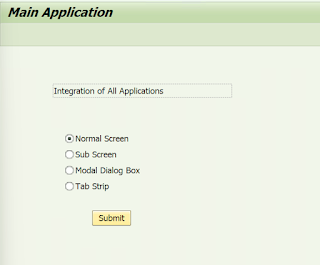Integrating Multiple Applications in SAP Module Pool Programming
Integration in Module Pool Programming generally refers to the process of connecting various components or modules within a Module Pool program in SAP ABAP. Module Pool programming in SAP is used to create interactive applications with a user-friendly interface.
Here's a general overview of how integration can be achieved in Module Pool Programming:
- Communication between Screens: Module Pool programs typically consist of multiple screens. Integration involves passing data between these screens. SAP provides various techniques for communication between screens, such as using global variables, exporting and importing parameters, and using memory ID.
- Data Sharing: Integration often involves sharing data between different modules or components within the same program. This can be achieved by declaring global data or by using memory objects like SAP memory, ABAP memory, or shared memory.
- Event Handling: Integration also includes handling events triggered by user actions or system events across different modules. This involves defining appropriate event handling routines and ensuring that events are correctly propagated and handled throughout the program.
- Navigation: Integration may involve navigating between different screens or modules based on user actions or business logic requirements. This can be achieved using various navigation statements provided by SAP, such as CALL SCREEN, SET SCREEN, LEAVE TO SCREEN, and LEAVE SCREEN.
- Error Handling and Validation: Integration also encompasses error handling and data validation across different modules. This involves implementing appropriate error-checking routines and validation logic to ensure data integrity and consistency throughout the application.
- Integration with Database: Module Pool programs often need to interact with the database to retrieve or update data. Integration with the database involves using Open SQL statements to perform database operations such as SELECT, INSERT, UPDATE, and DELETE within the program.
- Integration with Business Logic: Finally, integration in Module Pool programming involves integrating the user interface with the underlying business logic of the application. This includes implementing the necessary ABAP code to execute business processes, perform calculations, and enforce business rules based on user input.
Overall, integration in Module Pool Programming is essential for creating cohesive and efficient applications that provide a seamless user experience and fulfill the business requirements effectively.
Note :-
- Till now, in Module Pool Programming we have created 4 applications
- Using Normal Screen
- Using Sub Screen
- Using Modal Dialog box
- Using Tab Strip.
- Please refer to the previous blogs for them.
Requirement :-
-
Now, Suppose the Customer wants us to Integrate all these 4 applications into a Main Application.
-
Customer wants us to create 4 radio button and one Submit button.
Solution :-
-
Step 1 :- Create a Module Pool Program in SE38 ( ABAP Editor ).
-
Step 2 :- Navigate to SE80 by clicking on Object list display.
-
Step 3 :- Create a screen 100.
-
Step 4 :- Open the Layout on screen 100.
-
Step 5 :- Create a text field that would be the heading of the screen.
-
Step 6 :- Create 4 radio buttons.
-
Step 7 :- Create a push button → Submit and Also give its FCT code as SUBMIT.
-
Step 8 :- Also we need to define the radio buttons, so that only one radio button can be ticked at a time.
- Select all the four radio buttons.
- Click on edit → Grouping → Radio button group →define.
- Save the layout and activate the whole program.
-
Step 9 :- In the program, we need to define 4 variable of type radio buttons.
-
Step 10 :- Uncomment the PAI in flow logic of screen 100 to write the program logic.
-
Step 11 :- For every radio button we will pass the transaction code for our programs.
-
Step 12 :- Create a transaction code for our above program.
Code :-
*&---------------------------------------------------------------------*
*& Modulpool ZAR_MAIN_APPLICATION
*&---------------------------------------------------------------------*
*&
*&---------------------------------------------------------------------*
PROGRAM ZAR_MAIN_APPLICATION.
DATA : R1 type C,
R2 type C,
R3 type C,
R4 type C.
*&---------------------------------------------------------------------*
*& Module STATUS_0100 OUTPUT
*&---------------------------------------------------------------------*
*&
*&---------------------------------------------------------------------*
MODULE status_0100 OUTPUT.
SET PF-STATUS 'MAIN'.
SET TITLEBAR 'MAN'.
ENDMODULE.
*&---------------------------------------------------------------------*
*& Module USER_COMMAND_0100 INPUT
*&---------------------------------------------------------------------*
* text
*----------------------------------------------------------------------*
MODULE user_command_0100 INPUT.
IF R1 = 'X'.
CALL TRANSACTION 'ZAR_MODULE_POOL'.
ELSEIF R2 = 'X'.
CALL TRANSACTION 'ZAR_SUB_SCREEN'.
ELSEIF R3 = 'X'.
CALL TRANSACTION 'ZAR_MODULE_POOL_PROG'.
ELSEIF R4 = 'X'.
CALL TRANSACTION 'ZAR_MODULE_TAB_STRIP'.
ENDIF.
if sy-ucomm eq 'BACK'.
leave to SCREEN 0.
endif.
ENDMODULE.
Execute the Program :-
-
Here, we can select any radio button and Click on submit to go to our required destination.
-
For e.g. Select tab strip and click on submit
.png)










.png)
.png)

Bhiya give me mobile number
ReplyDelete